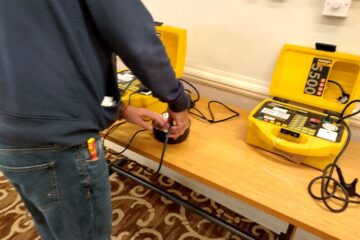PAT vs Pre-Supply: What’s the Difference?
PAT (in-service inspection & testing) is about keeping workplace equipment safe over time. It sits alongside the Electricity at Work Regulations and focuses on visual inspections and electrical tests at sensible intervals.
Supplying equipment (new or second-hand) is covered by product safety law. If you’re a retailer, refurbisher, charity shop, auction house or business seller online, you must take reasonable steps to ensure items are safe at the point of supply.
Although the legal frameworks are different, the practical checks overlap heavily—exactly what you learn on a PAT training course:
- Thorough visual inspection: damage, cracks, exposed parts, loose covers
- Plug, fuse and cord checks (BS 1363 plug, BS 1362 fuse, correct flex type & strain relief)
- Electrical tests: earth continuity, insulation resistance, leakage, polarity (as appropriate)
- Basic functional checks and safe operation
- Recording results to demonstrate due diligence
Why Charity Shops and Auctioneers Use PAT Methods
Many charity shops apply PAT methods to donated appliances before resale. Strictly speaking, that isn’t “PAT under the CoP” (because the item isn’t yet in service in a workplace), but it’s a practical and recognised way to show that reasonable safety checks were carried out.
Auctioneers and business sellers (including online) have similar responsibilities: even if items are “sold as seen”, knowingly passing on dangerous electrical goods can still breach product safety law. Using PAT techniques helps reduce that risk.
Who Benefits from PAT Training?
If you’re involved in any of the following, PAT training is directly useful:
- Charity retail and reuse operations
- Refurbishers and second-hand retailers
- Auction houses and logistics teams handling electricals
- Facilities/maintenance teams accepting donated kit into workplaces
- Business sellers on marketplaces (eBay, Facebook Shops, etc.)
Training gives you the confidence to identify unsafe appliances, apply the right tests, and document your decision-making—whether for workplace in-service checks or pre-supply safety assessments.
Side-by-Side: PAT vs Supply Duties
| Scenario | Covered By | What’s Required | Example |
|---|---|---|---|
| Workplace equipment in use | IET PAT CoP (5th Ed.) | Risk-based inspection & testing to keep it safe in service | Office kettle, site tools |
| New equipment for sale | Product safety law | Conformity assessment (e.g. UKCA/CE), technical documentation | Brand-new toaster |
| Second-hand equipment for sale | Product safety law (general safety duty) | Reasonable safety checks (visual & electrical), records | Charity shop TV, donated microwave |
| Online/auction supply | Product safety law (for business sellers) | Business sellers must ensure safety; private one-offs are typically exempt | eBay shop listing, auction lot |
Ready to Build These Skills?
A PAT Testing training course won’t just help you meet workplace obligations—it equips you with the visual inspection techniques, electrical tests, and record-keeping you’ll use to assess second-hand appliances responsibly, too.


0 Comments